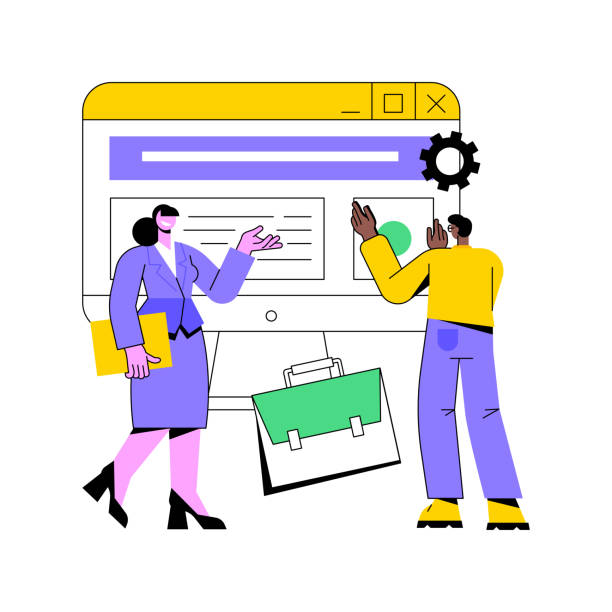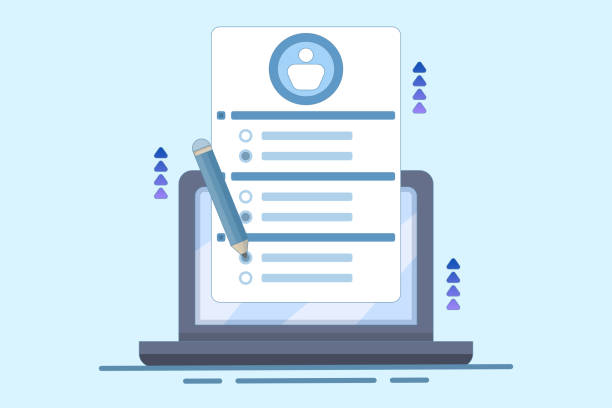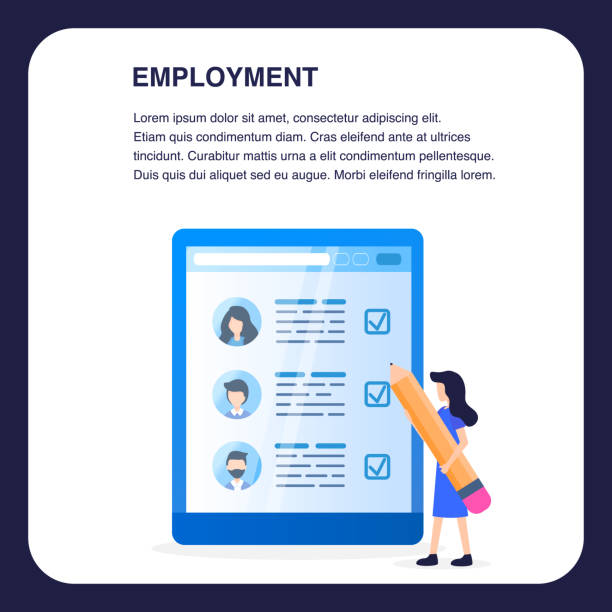What is Responsive Web Design and Why is it Important?

In today’s world, where #internet_access occurs through various devices such as mobile phones, tablets, laptops, and even smartwatches, the concept of #responsive_web_design or Responsive Web Design stands out more than ever.
Responsive web design refers to an approach where the #layout and #content of a website adapt to the screen size and orientation of the user’s device, providing an optimal user experience.
This means that users, regardless of the device they use, will encounter a fully compatible and user-friendly website.
The main goal of implementing responsive web design is to improve user experience and ensure seamless and smooth access to information.
The importance of this approach is not limited to users; from an #SEO and search engine perspective, websites that are correctly designed to be responsive achieve a better ranking, because Google prioritizes mobile-friendly websites.
This approach is, in fact, an #explanatory response to the challenge of proliferating devices and screens of different dimensions, and it forms the foundation of a successful online presence.
Without responsive web design, users will face cluttered websites, constantly needing to zoom in and struggling to navigate, which will quickly lead to site abandonment and dissatisfaction.
Did you know that poor online store design can drive away up to 70% of your potential customers? Rasaweb transforms your sales with professional and user-friendly e-commerce website design.
✅ Significant increase in sales and revenue
✅ Full optimization for search engines and mobile
⚡ [Get free consultation from Rasaweb]
Why Responsive Design Has Become a Necessity in Today’s World

The exponential growth in #mobile_phone usage for internet access has transformed responsive web design from a competitive advantage into an #indispensable_necessity.
Global statistics show that a significant portion of web traffic now comes from mobile devices.
This shift in content consumption has compelled developers and business owners to change their approach to web design.
In the past, many websites were designed with a “desktop-first” approach, but this perspective no longer meets the needs of today’s users.
Users expect websites to load quickly and without issues on any device and to provide a consistent experience.
Ignoring responsive web design leads to losing a large segment of potential audiences, reduced conversion rates, and ultimately, damage to brand reputation.
This #analysis clarifies why businesses and personal websites must move towards implementing this approach as quickly as possible.
Furthermore, the emergence of new technologies and diverse devices has reinforced this need more than ever.
#News_content in this field also constantly emphasizes the high importance of responsive design, introducing it as one of the main pillars of success in the digital space.
Key Principles in Responsive Web Design

#Responsive_web_design is based on three main pillars, the understanding of which is essential for every web developer and designer.
These principles include #fluid_grids, #flexible_images, and #media_queries.
Fluid grids mean that the website layout is built using relative units such as percentages instead of fixed pixels, allowing page elements to automatically resize.
Flexible images also mean that images and videos should be able to resize to fit the available space without losing quality or disrupting the layout.
This is typically achieved using CSS properties like `max-width: 100%` for images.
However, the most important component is #media_queries.
This CSS feature allows designers to apply different styles based on device characteristics such as screen width, height, orientation, and media type (screen or print).
For example, you can define that if the screen width is less than 768 pixels, the navigation menu should transform into a hamburger icon instead of a horizontal row.
These #specialized tools empower designers to create fully customized user experiences for each device.
Here is a comparative table of the features of these principles:
| Principle | Description | Application |
|---|---|---|
| Fluid Grids | Using relative units (e.g., percentages) to define the width and height of elements. | Automatic layout adjustment based on screen size. |
| Flexible Images | Adjusting the size of images and media using CSS to prevent overflow. | Maintaining aspect ratio and image quality across different screen sizes. |
| Media Queries | Applying different CSS styles based on device characteristics (width, height, orientation). | Customizing the appearance and user experience for different devices. |
These three principles form the foundation of responsive web design, enabling websites to display correctly across various environments and provide a consistent user experience.
Benefits of Responsive Design for Users and Businesses

Adopting #responsive_web_design brings countless benefits to both users and business owners.
From the user’s perspective, a seamless and optimal #user_experience is the most significant achievement.
The user no longer needs to zoom or scroll horizontally; the content automatically adjusts into a readable and navigable format, which helps #reduce_bounce_rate and increase user time spent on the site.
Easy access to information anytime, anywhere leads to greater satisfaction and repeated returns from users.
For businesses, the benefits extend beyond user experience.
Firstly, #SEO_improvement is one of the most prominent advantages.
Google and other search engines prefer responsive websites over separate mobile websites or non-responsive websites.
This is because a single codebase exists for all devices, simplifying crawling and indexing for search engines.
Secondly, reduced development and maintenance costs are other benefits.
Instead of developing and maintaining two or more separate versions of a website (for desktop and mobile), only one version needs to be managed, which results in time and resource savings.
Thirdly, an increase in #conversion_rate (Conversion Rate) through a better user experience and easier access to Call to Actions directly impacts business revenue.
Finally, strengthening #branding and brand positioning in the minds of the audience is an indirect but very important advantage of responsive web design.
A website that works well on all devices looks professional and modern, which in itself is a valuable guide for success in today’s competitive market.
Are you tired of losing business opportunities due to not having a professional corporate website? Rasaweb solves this problem with modern and efficient corporate website design.
✅ Increases your brand’s credibility.
✅ Helps attract targeted customers.
⚡ Contact Rasaweb for a free consultation!
Challenges and Common Mistakes in Implementing Responsive Design

Despite all its advantages, #implementing_responsive_web_design is not without its challenges and may be accompanied by common mistakes that can disrupt the user experience.
One of the biggest challenges is #performance_management and #loading_speed.
If images are not properly optimized or if CSS and JavaScript codes are excessively heavy, loading the site on mobile devices with slow internet will be time-consuming, leading to a poor user experience.
A #challenging_question often raised is: “Is optimization truly possible for all devices?” The answer is yes, but it requires precise planning and appropriate tools.
Another common mistake is ignoring “Mobile First”.
Many designers still start with a “Desktop First” approach and then try to “shrink” the design for mobile, which often leads to weak and inefficient solutions.
The correct approach is #mobile_first_design; that is, first design for the smallest screen (mobile) and then gradually add details for larger screens.
Also, #insufficient_testing on real devices is a big mistake.
Simulators and browser developer tools are useful, but they cannot fully replicate website behavior in a real environment.
The complexity of managing images for different screen sizes, as well as navigation on small screens, are other issues that require attention and #specialized solutions to ensure efficient responsive web design.
Tools and Technologies Facilitating Responsive Design

For effective #responsive_web_design implementation, a set of #tools and #technologies has been made available to developers and designers.
These tools make the design and development process much simpler and more efficient.
One of the most well-known approaches is the use of #CSS_frameworks.
Frameworks like Bootstrap and Foundation provide fluid grid systems, ready-made components, and powerful tools that make responsive design quickly achievable.
By offering pre-defined CSS classes for managing breakpoints and element layouts, these frameworks reduce the need to write large amounts of custom code.
In addition to frameworks, #CSS_preprocessors like Sass and LESS also play a crucial role.
These tools enhance CSS with features like variables, functions, and Nested Rules, making coding more organized, maintainable, and faster.
This is particularly useful in large projects with numerous media queries.
For testing and debugging, browser developer tools such as Chrome DevTools provide the ability to simulate various devices and test website responsiveness across different sizes.
Furthermore, image management tools like Gulp and Webpack help with #image_optimization and ensure their fast loading on various devices.
These #educational tools pave the way for better implementation of responsive web design and allow developers to focus more on the creative and functional aspects of the project.
The Future of Responsive Design Beyond Breakpoints

Responsive web design, despite its unparalleled importance, is evolving, and its future will extend beyond merely adjusting layouts based on breakpoints.
Future trends are moving towards #user-centric_design (User-Centric Design) and #personalized_experience (Personalized Experience).
Instead of solely responding to screen dimensions, websites should be able to respond to user preferences, network bandwidth, device processing power, and even location.
This more advanced approach, sometimes referred to as #adaptive_design (Adaptive Design) or #content-out_design (Content-Out Design), places content at the center of the design and tailors it to the specific needs of each user.
The emergence of artificial intelligence and machine learning can also play a significant role in this evolution.
Systems may be able to automatically suggest or apply the best layout and elements for each specific user, based on data collected from their behavior.
This is an exciting #analytical and #forward-looking approach that moves towards smarter and more dynamic websites.
Another important concept is the use of #CSS_Grid and #Flexbox as more powerful alternatives to older grid frameworks, providing greater flexibility in layout control.
These changes mean that responsive web design is never static and is constantly improving to provide a richer and more relevant experience for users.
| Approach | Primary Focus | Key Benefit |
|---|---|---|
| Responsive Design | Layout changes based on screen size | Consistent user experience across different devices |
| Adaptive Design | Loading different layouts based on device detection | More precise control over performance and experience for each device |
| User-Centric Design | Focus on user needs and preferences | Personalization and deeper user engagement |
Comparing Responsive and Adaptive Design

In the field of #web_design, the two terms #responsive_design (Responsive Design) and #adaptive_design (Adaptive Design) are often used interchangeably, but there are key differences between them.
Understanding these differences is essential for choosing the right approach for a project.
#Responsive_web_design, as previously explained, is based on a single layout that, using fluid grids, flexible images, and media queries, #smoothly and continuously “adapts” itself to the screen size of the user’s device.
This approach means that there is one HTML and CSS file for all devices, and the browser is responsible for its adjustment.
In contrast, #adaptive_design involves several fixed layouts that are pre-designed for specific screen sizes.
When a user visits an adaptive website, the server or browser identifies the user’s device and loads the appropriate layout from among the predefined designs.
For example, there might be one design for desktop, one for tablet, and one for mobile.
This #specialized approach offers more control over the user experience on each device and can, in some cases, lead to faster loading times, as only the code required for that specific device is loaded.
However, it entails the need to maintain multiple separate codebases, which can increase complexity.
Ultimately, the choice between these two approaches depends on the project’s specific needs, budget, and performance goals, and both can lead to a good user experience.
Are you concerned that your old company website might drive away new customers? Rasaweb solves this problem with modern and efficient corporate website design.
✅ Increases your brand’s credibility.
✅ Helps attract targeted customers.
⚡ Contact Rasaweb for a free consultation!
Step-by-Step Guide to Starting Responsive Design

For those who intend to convert their website to a #responsive_web_design or build a responsive website from scratch, a #step-by-step_guide can be very helpful.
The first step is the #mobile-first_approach (Mobile-First).
Instead of starting design for desktop and then trying to shrink it, first design for the smallest screen (mobile).
This helps you focus on core content and critical functionality, avoiding unnecessary clutter.
Then, gradually, using media queries, expand the design for larger screens (tablet and desktop) and add details and additional elements.
The second step is using #relative_units for font size, column widths, and margins.
Instead of fixed pixels, use `em`, `rem`, or percentages (%).
This allows elements to scale automatically with screen size changes.
The third step is #image_optimization.
Use high-quality images that are properly compressed, and if necessary, use the `srcset` and `sizes` attributes in the `img` tag to provide different versions of the image based on screen size.
The fourth step is #continuous_testing.
Regularly test your website on various physical devices and multiple browser sizes to ensure its correct performance under all conditions.
This practical #tutorial helps you implement a successful and efficient responsive web design and benefit from its advantages.
Responsive Design and Engaging User Experience

#Responsive_web_design is not just about resizing elements; it’s about creating an optimal and, in some cases, even #engaging #user_experience (UX) on every device.
A well-designed responsive website can increase user interaction with content and lead to longer site retention.
For example, a news site whose images and videos scale correctly on mobile and whose texts are easily readable provides a much more desirable experience than a site where the user is forced to constantly zoom.
This smooth navigation and easy access to content is in itself somewhat entertaining and appealing, as it frees the user from technical struggles and allows them unobstructed access to information.
In a creative responsive web design, specific interactive elements can even be considered for different devices.
For example, on touch devices, gestures might be used for navigation, while dropdown menus are utilized on desktop.
These customizations enrich the user experience and show that the designer has considered the specific needs of the user on each device.
On the other hand, #animations and #visual_effects must also be carefully optimized for responsiveness so that they do not slow down the site on devices with less processing power.
The ultimate goal is to provide a flawless and enjoyable experience that encourages the user to return and interact more with the site.
This #analytical approach demonstrates how a technical aspect can lead to an #engaging and user-friendly advantage.
Frequently Asked Questions
| Question | Answer |
|---|---|
| What is Responsive Web Design? | A web design approach where the website adapts to the screen size of various devices (desktop, tablet, mobile). |
| Why is Responsive Design important? | To provide an optimal user experience on any device the user employs and to improve SEO. |
| What are the main techniques of Responsive Design? | Using fluid grids, flexible images, and Media Queries. |
| What is a Media Query? | A CSS rule that allows applying different styles based on screen characteristics (such as width or height). |
| What are the benefits of Responsive Web Design? | Increased user satisfaction, improved website ranking in search engines (SEO), reduced maintenance costs compared to having separate versions for each device. |
And other services of Rasaweb Advertising Agency in the field of advertising
Smart Advertising Campaign: A creative platform for improving online growth using real data.
Smart Customer Journey Map: A quick and efficient solution for increasing website traffic with a focus on marketing automation.
Smart Custom Software: A combination of creativity and technology for campaign management through attractive UI design.
Smart Custom Software: Designed for businesses looking to increase sales through marketing automation.
Smart Link Building: Professional optimization for customer acquisition using key page optimization.
And hundreds of other services in the field of internet advertising, advertising consultation, and organizational solutions
Internet Advertising | Advertising Strategy | Advertorial
Resources
What is Responsive Web Design?What is Responsive Web Design (Responsive Design)?Responsive Web Design | Parsian HostWhat is Responsive Web Design and Why is it Important?
? To achieve your digital marketing goals and have an outstanding exclusive website design, Rasaweb Afarin is your best choice. With us, transform your business in the online world.
📍 Tehran, Mirdamad Street, next to Bank Markazi, Kazeroun Jonoubi Alley, Ramin Alley, No. 6



